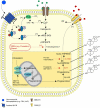Neurosteroids and GABA(A) Receptor Interactions: A Focus on Stress
- PMID: 22164129
- PMCID: PMC3230140
- DOI: 10.3389/fnins.2011.00131
Neurosteroids and GABA(A) Receptor Interactions: A Focus on Stress
Abstract
Since the pioneering discovery of the rapid CNS depressant actions of steroids by the "father of stress," Hans Seyle 70 years ago, brain-derived "neurosteroids" have emerged as powerful endogenous modulators of neuronal excitability. The majority of the intervening research has focused on a class of naturally occurring steroids that are metabolites of progesterone and deoxycorticosterone, which act in a non-genomic manner to selectively augment signals mediated by the main inhibitory receptor in the CNS, the GABA(A) receptor. Abnormal levels of such neurosteroids associate with a variety of neurological and psychiatric disorders, suggesting that they serve important physiological and pathophysiological roles. A compelling case can be made to implicate neurosteroids in stress-related disturbances. Here we will critically appraise how brain-derived neurosteroids may impact on the stress response to acute and chronic challenges, both pre- and postnatally through to adulthood. The pathological implications of such actions in the development of psychiatric disturbances will be discussed, with an emphasis on the therapeutic potential of neurosteroids for the treatment of stress-associated disorders.
Keywords: HPA axis; allopregnanolone; anxiety; maternal care; synaptic inhibition.
Figures


Similar articles
-
Neurosteroids: endogenous allosteric modulators of GABA(A) receptors.Psychoneuroendocrinology. 2009 Dec;34 Suppl 1:S48-58. doi: 10.1016/j.psyneuen.2009.08.009. Psychoneuroendocrinology. 2009. PMID: 19758761
-
Neuroactive steroids and inhibitory neurotransmission: mechanisms of action and physiological relevance.Neuroscience. 2006;138(3):821-9. doi: 10.1016/j.neuroscience.2005.07.021. Epub 2005 Nov 28. Neuroscience. 2006. PMID: 16310966 Review.
-
Neurosteroids and GABA-A Receptor Function.Front Endocrinol (Lausanne). 2011 Oct 4;2:44. doi: 10.3389/fendo.2011.00044. eCollection 2011. Front Endocrinol (Lausanne). 2011. PMID: 22654809 Free PMC article.
-
Realising the therapeutic potential of neuroactive steroid modulators of the GABAA receptor.Neurobiol Stress. 2019 Dec 23;12:100207. doi: 10.1016/j.ynstr.2019.100207. eCollection 2020 May. Neurobiol Stress. 2019. PMID: 32435660 Free PMC article.
-
Stress and drug abuse-related disorders: The promising therapeutic value of neurosteroids focus on pregnenolone-progesterone-allopregnanolone pathway.Front Neuroendocrinol. 2019 Oct;55:100789. doi: 10.1016/j.yfrne.2019.100789. Epub 2019 Sep 13. Front Neuroendocrinol. 2019. PMID: 31525393 Review.
Cited by
-
Neurosteroid Metabolites of Gonadal Steroid Hormones in Neuroprotection: Implications for Sex Differences in Neurodegenerative Disease.Front Mol Neurosci. 2018 Oct 5;11:359. doi: 10.3389/fnmol.2018.00359. eCollection 2018. Front Mol Neurosci. 2018. PMID: 30344476 Free PMC article. Review.
-
Endocrine and neurobehavioral abnormalities induced by propofol administered to neonatal rats.Anesthesiology. 2014 Nov;121(5):1010-7. doi: 10.1097/ALN.0000000000000366. Anesthesiology. 2014. PMID: 24992523 Free PMC article.
-
Neurosteroids and early-life programming: An updated perspective.Curr Opin Endocr Metab Res. 2022 Aug;25:100367. doi: 10.1016/j.coemr.2022.100367. Epub 2022 Jul 8. Curr Opin Endocr Metab Res. 2022. PMID: 36561280 Free PMC article.
-
Neurosteroids, stress and depression: potential therapeutic opportunities.Neurosci Biobehav Rev. 2013 Jan;37(1):109-22. doi: 10.1016/j.neubiorev.2012.10.005. Epub 2012 Oct 17. Neurosci Biobehav Rev. 2013. PMID: 23085210 Free PMC article. Review.
-
Chronic Stress Oppositely Regulates Tonic Inhibition in Thy1-Expressing and Non-expressing Neurons in Amygdala.Front Neurosci. 2020 Apr 17;14:299. doi: 10.3389/fnins.2020.00299. eCollection 2020. Front Neurosci. 2020. PMID: 32362809 Free PMC article.
References
LinkOut - more resources
Full Text Sources

